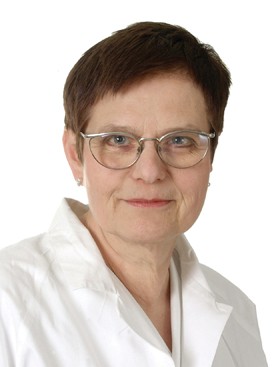User login
Adding radiation therapy to lifelong antiandrogen therapy dramatically cuts the long-term risk of death from prostate cancer in men with locally advanced disease, according to updated results of the Scandinavian Prostate Cancer Group’s Study VII.
Compared with antiandrogen therapy alone, the combination more than halved the 10- and 15-year rates of prostate cancer–specific mortality, lead author Dr. Sophie Dorothea Fosså reported in a press briefing preceding the 2014 Genitourinary Cancers Symposium sponsored by the American Society of Clinical Oncology. In fact, the benefit increased with the duration of follow-up.
"Given the high mortality reduction and, what is important, only 8% prostate cancer–specific mortality at 10 years, our conclusion is that this combination of radiotherapy and hormones may be considered as a standard curative treatment option in these patients," she commented. "And it is actually ... more or less comparable to a modern prostatectomy series."
Approximately 30%-40% of the patients studied would likely undergo prostatectomy today, estimated Dr. Fosså, who is a professor in the department of oncology at Oslo University Hospital. But it remains unclear whether that treatment is better because other studies testing the combination of radiation therapy and antiandrogens have used much lower doses of radiation, now known to be inadequate.
"Therefore, a randomized trial is absolutely necessary. There is a new trial planned in the Scandinavian Prostate Cancer Group of radiotherapy plus at least 3 years with antiandrogens compared to prostatectomy," she said, noting that shorter durations of hormone treatment are now the norm.
Press briefing moderator Dr. Charles J. Ryan of the division of hematology/oncology at the University of California, San Francisco, and leader of the genitourinary medical oncology program there, said that the study presented is noteworthy for several reasons.
"One is it’s very interesting to see that these results continue to improve over time, which is somewhat different than some other randomized trials where sometimes results actually worsen over time," he elaborated. "Also of note is that this is the use of an antiandrogen as opposed to medical castration lifelong; that’s something that makes this trial somewhat unique."
Men from Norway, Sweden, and Denmark were eligible for the Scandinavian Prostate Cancer Group’s study if they had locally advanced or high-risk prostate cancer and were aged 75 years or younger; 80% had extension of disease beyond the prostatic capsule. Such patients were not considered surgical candidates in 1996, when the trial began, according to Dr. Fosså.
All 875 patients received 3 months of medical castration therapy, consisting of leuprolide injection (Procren Depot) plus oral flutamide (Eulexin). Half then received lifelong antiandrogen therapy alone (oral flutamide), whereas the other half received that therapy plus initial radiation therapy consisting of 75 Gy to the prostate, "which, at that time, was a relatively high dose," she noted.
Initial results, previously reported after a median follow-up of 7.6 years, showed a 12% reduction in prostate cancer–specific mortality in patients with the addition of radiation therapy (Lancet 2009;373:301-8).
Updated results, now after median follow-up of 10.7 years, showed the 10-year cumulative prostate cancer–specific mortality was more than halved by the addition of radiation therapy, from 19% to just 8%, reported to Dr. Fosså, who disclosed no relevant conflicts of interests related to the research.
The trial therefore far exceeded its primary endpoint of a reduction of at least 10% in 10-year prostate cancer–specific mortality from the addition of radiation therapy.
There was also a reduction in overall mortality at this time point, from 35% without radiation therapy to 26% with it.
The 15-year cumulative prostate cancer–specific mortality was also more than halved by the addition of radiation therapy, from 31% to 12%, and overall mortality was reduced by a quarter, from 57% to 43%.
Adding radiation therapy to lifelong antiandrogen therapy dramatically cuts the long-term risk of death from prostate cancer in men with locally advanced disease, according to updated results of the Scandinavian Prostate Cancer Group’s Study VII.
Compared with antiandrogen therapy alone, the combination more than halved the 10- and 15-year rates of prostate cancer–specific mortality, lead author Dr. Sophie Dorothea Fosså reported in a press briefing preceding the 2014 Genitourinary Cancers Symposium sponsored by the American Society of Clinical Oncology. In fact, the benefit increased with the duration of follow-up.
"Given the high mortality reduction and, what is important, only 8% prostate cancer–specific mortality at 10 years, our conclusion is that this combination of radiotherapy and hormones may be considered as a standard curative treatment option in these patients," she commented. "And it is actually ... more or less comparable to a modern prostatectomy series."
Approximately 30%-40% of the patients studied would likely undergo prostatectomy today, estimated Dr. Fosså, who is a professor in the department of oncology at Oslo University Hospital. But it remains unclear whether that treatment is better because other studies testing the combination of radiation therapy and antiandrogens have used much lower doses of radiation, now known to be inadequate.
"Therefore, a randomized trial is absolutely necessary. There is a new trial planned in the Scandinavian Prostate Cancer Group of radiotherapy plus at least 3 years with antiandrogens compared to prostatectomy," she said, noting that shorter durations of hormone treatment are now the norm.
Press briefing moderator Dr. Charles J. Ryan of the division of hematology/oncology at the University of California, San Francisco, and leader of the genitourinary medical oncology program there, said that the study presented is noteworthy for several reasons.
"One is it’s very interesting to see that these results continue to improve over time, which is somewhat different than some other randomized trials where sometimes results actually worsen over time," he elaborated. "Also of note is that this is the use of an antiandrogen as opposed to medical castration lifelong; that’s something that makes this trial somewhat unique."
Men from Norway, Sweden, and Denmark were eligible for the Scandinavian Prostate Cancer Group’s study if they had locally advanced or high-risk prostate cancer and were aged 75 years or younger; 80% had extension of disease beyond the prostatic capsule. Such patients were not considered surgical candidates in 1996, when the trial began, according to Dr. Fosså.
All 875 patients received 3 months of medical castration therapy, consisting of leuprolide injection (Procren Depot) plus oral flutamide (Eulexin). Half then received lifelong antiandrogen therapy alone (oral flutamide), whereas the other half received that therapy plus initial radiation therapy consisting of 75 Gy to the prostate, "which, at that time, was a relatively high dose," she noted.
Initial results, previously reported after a median follow-up of 7.6 years, showed a 12% reduction in prostate cancer–specific mortality in patients with the addition of radiation therapy (Lancet 2009;373:301-8).
Updated results, now after median follow-up of 10.7 years, showed the 10-year cumulative prostate cancer–specific mortality was more than halved by the addition of radiation therapy, from 19% to just 8%, reported to Dr. Fosså, who disclosed no relevant conflicts of interests related to the research.
The trial therefore far exceeded its primary endpoint of a reduction of at least 10% in 10-year prostate cancer–specific mortality from the addition of radiation therapy.
There was also a reduction in overall mortality at this time point, from 35% without radiation therapy to 26% with it.
The 15-year cumulative prostate cancer–specific mortality was also more than halved by the addition of radiation therapy, from 31% to 12%, and overall mortality was reduced by a quarter, from 57% to 43%.
Adding radiation therapy to lifelong antiandrogen therapy dramatically cuts the long-term risk of death from prostate cancer in men with locally advanced disease, according to updated results of the Scandinavian Prostate Cancer Group’s Study VII.
Compared with antiandrogen therapy alone, the combination more than halved the 10- and 15-year rates of prostate cancer–specific mortality, lead author Dr. Sophie Dorothea Fosså reported in a press briefing preceding the 2014 Genitourinary Cancers Symposium sponsored by the American Society of Clinical Oncology. In fact, the benefit increased with the duration of follow-up.
"Given the high mortality reduction and, what is important, only 8% prostate cancer–specific mortality at 10 years, our conclusion is that this combination of radiotherapy and hormones may be considered as a standard curative treatment option in these patients," she commented. "And it is actually ... more or less comparable to a modern prostatectomy series."
Approximately 30%-40% of the patients studied would likely undergo prostatectomy today, estimated Dr. Fosså, who is a professor in the department of oncology at Oslo University Hospital. But it remains unclear whether that treatment is better because other studies testing the combination of radiation therapy and antiandrogens have used much lower doses of radiation, now known to be inadequate.
"Therefore, a randomized trial is absolutely necessary. There is a new trial planned in the Scandinavian Prostate Cancer Group of radiotherapy plus at least 3 years with antiandrogens compared to prostatectomy," she said, noting that shorter durations of hormone treatment are now the norm.
Press briefing moderator Dr. Charles J. Ryan of the division of hematology/oncology at the University of California, San Francisco, and leader of the genitourinary medical oncology program there, said that the study presented is noteworthy for several reasons.
"One is it’s very interesting to see that these results continue to improve over time, which is somewhat different than some other randomized trials where sometimes results actually worsen over time," he elaborated. "Also of note is that this is the use of an antiandrogen as opposed to medical castration lifelong; that’s something that makes this trial somewhat unique."
Men from Norway, Sweden, and Denmark were eligible for the Scandinavian Prostate Cancer Group’s study if they had locally advanced or high-risk prostate cancer and were aged 75 years or younger; 80% had extension of disease beyond the prostatic capsule. Such patients were not considered surgical candidates in 1996, when the trial began, according to Dr. Fosså.
All 875 patients received 3 months of medical castration therapy, consisting of leuprolide injection (Procren Depot) plus oral flutamide (Eulexin). Half then received lifelong antiandrogen therapy alone (oral flutamide), whereas the other half received that therapy plus initial radiation therapy consisting of 75 Gy to the prostate, "which, at that time, was a relatively high dose," she noted.
Initial results, previously reported after a median follow-up of 7.6 years, showed a 12% reduction in prostate cancer–specific mortality in patients with the addition of radiation therapy (Lancet 2009;373:301-8).
Updated results, now after median follow-up of 10.7 years, showed the 10-year cumulative prostate cancer–specific mortality was more than halved by the addition of radiation therapy, from 19% to just 8%, reported to Dr. Fosså, who disclosed no relevant conflicts of interests related to the research.
The trial therefore far exceeded its primary endpoint of a reduction of at least 10% in 10-year prostate cancer–specific mortality from the addition of radiation therapy.
There was also a reduction in overall mortality at this time point, from 35% without radiation therapy to 26% with it.
The 15-year cumulative prostate cancer–specific mortality was also more than halved by the addition of radiation therapy, from 31% to 12%, and overall mortality was reduced by a quarter, from 57% to 43%.
FROM THE GENITOURINARY CANCERS SYMPOSIUM
Major finding: Addition of radiation therapy to lifelong antiandrogen therapy reduced 10-year prostate cancer–specific mortality from 19% to 8%.
Data source: A randomized phase III trial among 875 men with locally advanced prostate cancer (Scandinavian Prostate Cancer Group’s Study VII)
Disclosures: Dr. Fosså disclosed no relevant conflicts of interest.


